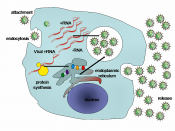Hepatitis CHepatitis C was discovered in 1989 from the reliance of molecular biology and ultimately revolutionized the way patients with liver disease were treated. The genetic material of hepatitis C is RNA, which encodes a large protein that is processed in infected host cells into smaller structural and nonstructural proteins. The detection of antibodies against these proteins in the blood of the infected person plays a important part in diagnosis and screening of the common blood supply. No one has ever provided proof of ever seeing the actual virus although many have claimed to have seen it. (Worman 136) Hemophiliacs and drug users have highest risk of acquiring the virus but anyone can get it. In inner city hospitals 20 to 40 percent of the patients there have HCV. The virus is more common in minority groups than in Hispanic whites. Many things can put you at risk for HCV such as injected drugs, being exposed to human blood, received a blood transfusion or blood products before 1992 or overseas (Turkington, 13).
The hepatitis C virus affects the liver, as well as other cells such as white blood cells and the lymphatic system. This is thought to make the disease more complicated to treat. People with chronic HCV (hepatitis c virus) may experience a broad array of symptoms. Symptoms may include flu like illness with chills and fever, stabbing pains in liver region, indigestion, irritable bowel syndrome, joint pains, vivid dreams and night sweats, depression, moody, chronic fatigue or sudden attacks of exhaustion, abdominal bloating, frequent urination, loss of appetite, aversion to fatty foods, itchy skin, diarrhea, irregular or poor sleep quality, chest pains, palpitations puffy face, swelling under armpits, in groin area, and around the neck, blood sugar disorders, and dizziness or peripheral vision problems. HCV is...


